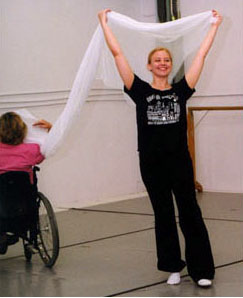STARKVILLE, Miss.—When British model, entrepreneur and amputee Heather Mills McCartney spoke to a conference in Jackson celebrating the achievements of people with disabilities, there was at least one woman in the audience who completely identified with her.
A dancer her entire life, Margaret McCarty, of Starkville, lost her left leg three years ago when a drunk driver crashed into her. Like McCartney, whose left leg was severed when she was hit by a police motorcycle responding to a call, McCarty was determined to succeed despite her disability.
At the conference, the two women had a chance to meet.
“It was great to be able to talk to her,” said McCarty. “We have a lot in common and I’ve learned so much from how she’s handled everything since her accident. She hasn’t let her disability stop her from doing anything. She’s such an inspiration to me.”
McCartney, a Nobel Peace Prize nominee and the wife of singer and former Beatle Sir Paul McCartney, has made a career of counseling people who have lost limbs in accidents or through illness, natural disasters or terrorist attacks. She also campaigns to increase awareness and raise money to remove land mines from war-torn countries.
McCartney spoke fervently of the importance of maintaining self-confidence, a philosophy exemplified by the 22-year-old McCarty.
Today, less than three years after McCarty lost her leg, she is back on stage. Each week, she practices with a small group of dancers for an upcoming show that will highlight the skills of physically challenged performers. The June 28 show—Medalists and Mississippians—will also feature competitors from past International Ballet Competitions.
“It was weird at first,” she said of dancing again for the first time since the injury. “I walked in and everyone was stretching and warming up and it took a minute. But when I started with them, it was so exciting.”
Dancing has always been a passion for McCarty, but the loss of her leg nearly ended the affair.
Her left leg was severed immediately when a drunk driver plowed into her as she was unloading the trunk of her car, pinning her between the two vehicles.
Several difficult surgeries followed to save as much of her remaining leg as possible. But as physicians worked to help her recover, they made a shocking discovery—McCarty had a brain tumor.
“In a way, the whole thing was a blessing,” she said. “Surgeons removed the tumor, but I doubt it would have ever been found if I hadn’t been hospitalized.”
Technicians at Methodist Rehabilitation Center went to work crafting a new left leg for McCarty. “We knew we had to make a leg that would be durable because we knew Margaret would put it through its paces,” said Brad Kennedy, himself a left-leg amputee who know designs and builds artificial limbs at Methodist Rehab’s east campus in Flowood.
Part of the challenge in designing a leg for McCarty was adapting it to her traumatic amputation. “Obviously, it’s easier when a surgeon performs the amputation,” said Kennedy. “Margaret had a lot of scar tissue and we have to be very careful that we create a good fit for her.”
Otherwise, the prosthetic leg could create skin abrasions and pressure, which would lead to a breakdown in her residual limb, Kennedy explained.
McCarty’s new leg has an adjustable heel that allows her to walk in high-heeled shoes. It’s one more thing limb designers have learned to help make the transition to an artificial limb easier. “Margaret is super active and ambitious,” Kennedy said. “We want to make sure to address every thing she wants to do and try to have a way for her to do it.”
As an example, McCarty’s leg has a dual locking device, Kennedy added. “We use lightweight material and create a total contact fit. That means she can be active and not have to worry about her leg coming off.”
Even after losing a leg and having a brain tumor removed, McCarty can light up a room with her smile. Besides continuing to dance, she plans on studying child counseling. “I really want to be able to work with children in hospitals who have serious injuries. I think there’s definitely a need for that.”
No one in Methodist Rehab’s orthotics and prosthetics division doubts her. “I’ve never seen her without a smile on her face,” said Chris Wallace, division director. “Most people would have crumbled after everything she’s been through, but not her.”

